Sacred Connections Scotland
IONA: SACRED ISLE OF THE WEST
Barry Dunford
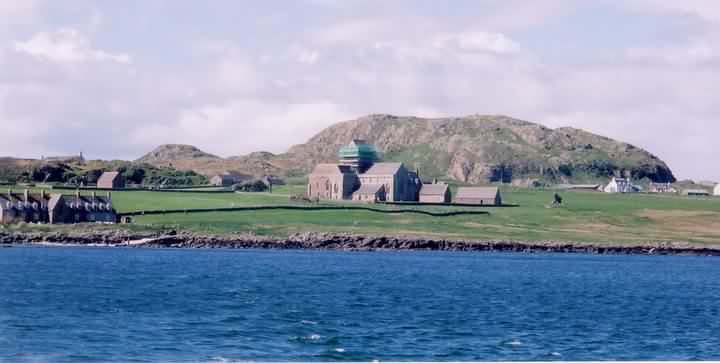
The ancient Abbey of Iona
What gives rise to the spiritual magnetism of the Holy Isle of Iona, located off the west coast of Scotland, which seems to elevate it above numerous other “holy isles” dotted around the globe? An almost universal recognition that somehow this sacred Isle is set apart from other earthly sites of spiritual sanctity.
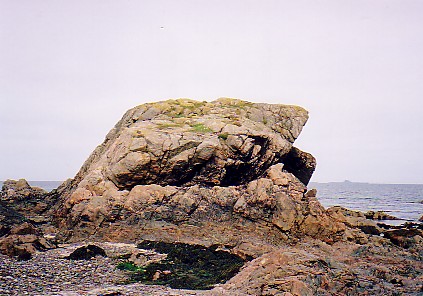
The archiac rock strata on Iona
It is generally believed that the archaic rock strata of Iona is some of the oldest on the planet, possibly 1500 million years old, and as such it certainly carries a primeval and powerfully creative energy. As the Scottish writer, William Sharp, writing under the pseudonym Fiona Macleod, poetically expressed: “To tell the story of Iona is to go back to God, and to end in God.”
This holy Isle’s primary claim to historical fame has resulted from the Christian mission of the Irish Saint Columba who came to Iona during the 6th century A. D. This is reflected in the name Icolmbkill (the Isle of the cell of Columba) which was subsequently bequeathed to the ancient Isle. But long before the time of Columba, Iona had been known by the old gaelic name Innis nan Druidhneach which translates as the Island of the Druids. Moreover, it appears that Iona was a primary seat of learning for the pre-Christian Celtic Druid Magi. Aylett Sammes, in his work Britannia Antiqua Illustrata (1676), states that Scotland was supposed to be the “Original and Capital Seat” of the Druids, and writing about the Druids, the Scottish researcher Lewis Spence says: “Their chief seat in Scotland was the Island of Iona (The Mysteries of Britain, 1928).
There is some reason to believe that at an early date these Druid priests converted to the Christian faith forming a monastic order of the early Celtic Church known as the Culdees, which derives from the gaelic Culdich (“certain strangers”) and the Latin Coli Dei meaning servants of the Lord or God. The 19th century antiquary, Godfrey Higgins, notes: “In the early history of the Christian church, in Britain and Ireland, we meet with an order of priests called Culdees…. They had a very celebrated monastery in the island of Iona, and others in remote situations, and these situations, by accident or design, mostly the former possessions of the Druids…. The result of all the enquiries which I have made into the history of the Culdees is, that they were the last remains of the Druids, who had been converted to Christianity, before the Roman church got any footing in Britain. They were Pythagorean Druidical monks, probably Essenes, and this accounts for their easily embracing Christianity: for the Essenes were as nearly Christians as possible.” (The Celtic Druids, 1829) This is further supported by John Jamieson D. D. in his Historical Account of the Ancient Culdees of Iona (1811) who remarks: “There is, I am informed, a pretty general tradition in the highlands of Scotland, that the Culdees immediately succeeded the Druids, as the ministers of religion…. The tradition that the Culdees succeeded the Druids at no great distance of time might seem to be supported by a circumstance of an interesting nature, which has been mentioned by several writers in our statistic accounts; that Clachan, the name still given in the Highlands to the place where a church stands, originally belonged to a Druidical temple.”
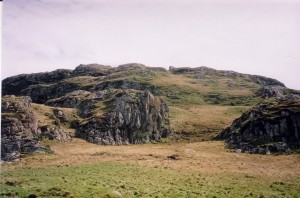
Dun I (the most elevated point on Iona)
This Celtic Culdee connection is commented on by the French oriental scholar, Henry Corbin, in The Imago Templi in Confrontation (1974) who says: “The primitive Celtic Church, prior to Romanization, is represented by groups of monks known as Culdees.. The groups of companions called by this name seem, moreover, to have played a much larger role in Scotland than in Ireland.. these autonomous groups of hermit brothers correspond to what we know of the original structure of the Celtic Church.. these Coli Dei [Culdees] had a role to play on the Celtic side analogous to the role attributed on the eastern side.. to the canons of the Holy Sepulchre, the spiritual descendants of the Essenes. The appeal to a distant Celto-Scottish filiation parallels the appeal made to affilitation with the builders of the Temple of Solomon and the community of Jerusalem. It is as if the double line of descent, Hierosolymitan and Scottish, linked, Ab origine symboli, the Church of James and the Celtic Church in the trials and misfortunes from which the Temple knighthood have to rescue them.” Corbin continues: “The Coli Dei are also included in the spiritual line of descent from the builders of the Temple of Solomon, the line of the Essenes, the Gnostics, even the Manichaeans and the Ismailis. They were established at York in England, at Iona in Scotland, in Wales, and in Ireland; their favourite symbol was the dove, the feminine symbol of the Holy Spirit. In this context, it is not surprising to find Druidism intermingled with their tradition and the poems of Taliesin integrated to their corpus. The epic of the Round Table and the Quest of the Holy Grail have likewise been interpreted as referring to the rights of the Coli Dei. It was, moreover, to the time of the Coli Dei that is assigned the formation of the Scottish knighthood whose seat is typified by the mysterious sanctuary of Kilwinning, under the shadow of Mount Heredom in the extreme north of Scotland.”
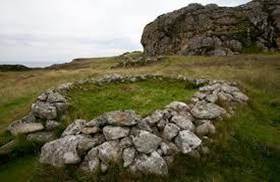
Iona stone circle
Commenting on the Druid and Culdee presence on Iona, a 19th century scottish travel writer, C. F. Gordon Cumming, observes: “What attraction it can have offered, to enduce the priests of the Sun to select it as their abode, it is hard to imagine, but, from time immemorial, it was known as the Sacred Isle of the Druids…. It certainly is a strangely perplexing mystery, to find an insignificant little island, in this remote corner of the earth, exhorted to a position of such extraordinary honour…. to anyone versed in the lore of the past, every corner of this Isle seems haunted by the spirits of Druids and Culdees…. My favourite evening stroll was a solitary expedition across the moor towards the western side of this Isle, to the wildest rocky valley, where a small circle of stones is still dear to the islanders, as the Cappan Cuildich, or Tabernacle of the Culdees, for here, they say, it was, that the Standard of the Cross was first planted, and that the little band of Christians were wont to assemble in secret, to worship after the new fashion taught them by these strange Missionaries. The circle was, however, probably of older date still; its avenue of carefully- placed stones seems rather to belong to the buildings we call Druidic, and whether as temple or tomb, was probably associated with the earlier form of worship.” (In the Hebrides, 1886)
More recently, after visiting Iona during the 1950’s, two spiritual seekers, George and Helen Sandwith, relate: “What is the magic in the name Iona which lures men and women from the far corners of the earth to the tiny rocky island off the west coast of Scotland? Surely not the scenery, for there is more magnificence on the mainland of Scotland. It must be something deeper. Something knocking on the heart which speaks of mystery and holiness, of dreams and truths which have outlived time…. There is an indescribable atmosphere in Iona as if a ‘Presence‘ dwells in the hallowed soil of the tiny island which has been washed by the waters of prayer down through the ages. Hallowed and blessed by St. Columba and countless Christians for about 1,400 years, as well as by those who were there long before St. Columba, is it any wonder that an aura of spiritual peace surrounds the island (The Miracle Hunters, 1959).
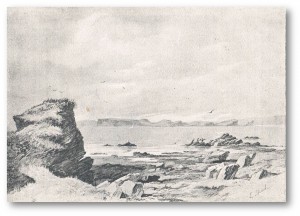
Eilean Isa (Island of Jesus)
Could it be that this sacred Presence noted by the Sandwiths has to do with the possible presence of Christ Himself on Iona? The Scottish literary writer, William Sharp, in his essay Iona (1900) refers to “the old prophecy that Christ shall come again upon Iona.” This presupposes that Christ had already visited Iona according to an ancient oral tradition. Curiously, just 80 miles due north of Iona is to be found another small Hebridean island, located in Dunvegan Bay, off the west coast of the Scottish Isle of Skye. It is called Eilean Isa (currently spelt Isay) which translates from the gaelic as the “Island of Jesus”. Isa is the Middle Eastern arabic name for Jesus, whereas His name in gaelic is Iosa. So why do we find the appellation of this island with the arabic spelling rather than the gaelic? Interestingly, there are no religious sites on Eilean Isa or anything to suggest that it’s name was conceived from a religious dedication. So it could be conjectured that the “Island of Jesus” was so named as a result of it being sanctified by the presence of Jesus (Isa) Himself. During the early centuries A. D. a placename was often given to record the actual presence and sanctification of a specific place by the early Celtic Christian monastic saints. Could this explain the appellation of the “Island of Jesus” to record the actual presence of Jesus on this particular Island.
Furthermore, while visiting the Scottish Hebridean Islands around 1895, Henry Jenner, a former keeper of the manuscripts department at the British Museum in London, came across an intriguing oral tradition. In an article published in The Western Morning News in 1933, Jenner wrote “I was staying on South Uist, in the Catholic part of the outer Hebrides, and found there a whole set of legends of the wanderings of the Holy Mother and Son in those Islands.” Taking the foregoing associative elements into account the idea that Jesus (Isa) might actually have visited Iona may not be as far fetched as would at first appear to be the case.
Enlarging upon the Iona prophecy as related by William Sharp (Fiona Macleod) in his essay on Iona, this author relates: “When I think of Iona I think often, too, of a prophecy once connected with Iona…. the old prophecy that Christ shall come again upon Iona, and of that later and obscure prophecy which foretells, now as the Bride of Christ, now as the Daughter of God, now as the Divine Spirit embodied through mortal birth in a Woman, as once through mortal birth in a man, the coming of a new Presence and Power: and dream that this may be upon Iona, so that the little Gaelic island may become as the little Syrian Bethlehem…. the Shepherdess shall call us home. A young Hebridean priest once told me how, ‘as our forefathers and elders believed and still believe, that Holy Spirit shall come again which once was mortally born among us as the Son of God, but, then, shall be the Daughter of God. The Divine Spirit shall come again as a Woman. Then for the first time the world will know peace’.” Interestingly, in the Hebridean mythos Christ is called “the Shepherd of the flocks”, while St. Bride is referred to as “the Shepherdess of the flocks”. (vide Carmina Gadelica). A similar relationship between Jesus and Mary Magdalene is implied in the early Christian gnostic texts.
William Sharp continues: “Nor must I forget that my old nurse, Barabal, used to sing a strange oran, to the effect that when St. Bride came again to Iona it would be to bind the hair and to wash the feet of the Bride of Christ…. Legend itself is more ancient here than elsewhere. Once a woman was worshipped. Some say she was the moon, but this was before the dim day of the moon-worshippers. (In Gaelic too, as with all the Celtic people, it is not the moon but the sun that is feminine.) She may have been an ancestral Brighde, or that mysterious Anait [ancient Mother Goddess of the East] whose Scythian name survives elsewhere in the Gaelic west, and nothing else of all her ancient glory but that shadowy word.”
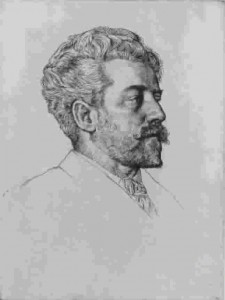
William Sharp (Fiona Macleod)
Commenting on St. Bride, Eleanor Merry refers to: “Bride, who is the soul of the ancient Mysteries – She is the Virgin-Sophia, the Virgin of Light whom the Bards once met among the stars. Companion of Christ, she came down to Earth with Him….” (The Flaming Door, 1962). Moreover, Alice O. Howell in The Dove in the Stone
(1988) says: “There in the Gaelic tongue the prayers and songs rose and fell, with a Christian overlay, to the unflagging devotion to Sophia, first called Brith (or Brid), then St. Brigid, the Mary of the Gael…. What Sophia offers is a view of the earth beyond the ego’s arrogance, an empirical experience, at long last, of the Holy all about us. It is akin to what a dedicated gardener may sense. It sheds light on Mary Magdalen, who, of all the women around Jesus, was first to see the risen Christ, thinking he was ‘the gardener’ in the garden…. The presence of the feminine is essential to the masculine for spiritual rebirth, and vice versa. Even the alchemist required a soror mystica, a mystical sister, to perform the opus.”
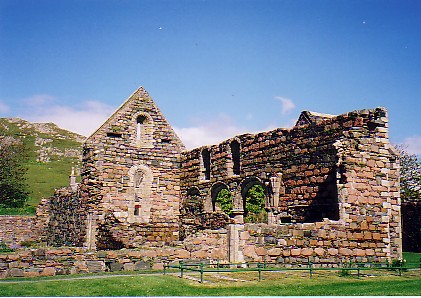
The Nunnery on Iona, a Benedictine Priory founded in 1203 A. D.
Continuing with this theme, in her penetrating study into the ancient Celtic mythos entitled The Flaming Door: A Preliminary Study of the Mission of the Celtic Folk- Soul by means of Legends and Myths (1962), Eleanor C. Merry says: “Certainly an immense paradox was concealed in the symbolic presentation of the male and female statues in the Hibernian initiation; the paradox that though what appears in feminine form in the world is passive, yet the supersensible nature that lies behind it is active. On the other hand, what appears in masculine form presents outwardly the active principle, and inwardly the passive one. One must receive, the other give. But the aspect that is revealed on the physical plane is reversed on the spiritual plane. In greater or lesser degree this paradox is always present in the sexes. Every man has the woman within him; every woman the man. This is well known. But it is also a fundamental principle of world-evolution, giving rise to a kind of cosmic conflict which urges evolution onwards towards its fulfilment. The fulfilment consists in the harmonising of these male-female principles. We find them in nations, in epochs of civilisation, as in individuals – sometimes the spiritually active (feminine) and sometimes the spiritually passive (masculine) predominates. The physical masculine element, which is that of ‘Becoming’ in the evolution of man on Earth, must gradually absorb more and more of the cosmic feminine, the active spiritual principle. Expressed in another way, it is what is meant in the evolution of the ‘Rose and the Lily’…. The saying of St. Bride rings through the centuries as a cosmic utterance: ‘My mantle shall be laid on the Lord of the World’; for the Lord of the World is, in reality, the Christ, suffering in the darkness of human ignorance, on the Earth. And the real fulfilment of the words of Bride is to be found in the saying of St. Paul: ‘Not I, but Christ in me.’ This foreshadows the marriage of the Rose and the Lily.”
Eleanor Merry also remarks: “In the Gospel of John we find something quite different. The Mother of Jesus, Mary-Sophia, is to be united with the beloved disciple: ‘Woman, behold thy son!’ John takes the divine Wisdom of the world into his heart. And the last words from the Cross are: ‘It is finished’. What is finished? Not the mission of Christ, because its fulfilment is hardly begun. But the ‘contraction’ of the whole spiritual Universe into the material creation of man and the Earth – that was finished. The ‘expansion’ was to begin; the redemption of the divine Wisdom by man was to begin. The Book of Revelation looking far into the future was its first- fruits…. John gazes with Eagle-vision into the infinite future evolution of the world, and writes of the past: ‘It is finished’…. John crosses over from past to future, because he has the secret of the Creative Word which continues: ‘I am with you always, even unto the end of the world.’ He sees the future because he has understood the Beginning. He is united with the divine Wisdom Sophia-Mary, whose symbol, from the Father, is the Dove. The Eagle of vision becomes the ‘Dove of the Eternal’. John, through the ‘John Christians’, carries into the future the Mysteries of the Word from East to West. Out of this there arose what became known in the ninth century as the Wisdom of the Grail, whose Knights had the emblem of the Dove on their armour. But first it had to be united with the stream of the Celtic Mysteries of the West, brought Eastward to Europe by the pupils of St. Columba. And this union is already foreshadowed in the words of the daughter of the West, Bride: ‘My garment‘ (Western Mysteries) ‘shall be laid on the Lord of the World‘….
“Anyone who studies the Celtic legends and traditions which are linked with the early centuries of the Christian era, will be impressed by the atmosphere of beauty that pervades them. Mingled with the fragments of an ancient Druid culture and wisdom there is the childlike purity and ecstasy of a Christianity quite unlike that which is to be found later. It is enclosed like a delicate seed within the old and dying splendour of the Great Mystery Centres of Ireland; it is a Christianity that, in its pristine purity is no longer to be found on the surface of civilisation. It is still hidden in the hearts of a few, and in solitary places. More than any other writer Fiona Macleod was its apostle; and he longed for its true history to be made known through the story of Iona: ‘What a book it will be! It will reveal to us the secret of what Oisin sang, what Merlin knew, what Columba dreamed, what Adamnan hoped: what this little ‘lamp of Christ’ was to pagan Europe; what incense of testimony it flung upon the winds; what saints and heroes went out of it; how the dust of kings and princes were brought there to mingle with its sands; how the noble and the ignoble came to it across long seas and preilous countries…. And how, slowly, a long sleep fell upon the island, and only the grasses shaken in the wind, and the wind itself, and the broken shadows of dreams in the minds of the old, held the secret of Iona’. The foundations of Celtic Christianity had a peculiar and deeply esoteric quality.” As mystical Iona played a central role in establishing these foundations of Celtic Christianity in the past, is this sacred role to be carried forward into the future in some profound way effecting the spiritual evolutionary course of humanity?
Writing in 1904, William Sharp (Fiona Macleod) dedicated his final literary work The Winged Destiny: Studies in the Spiritual History of the Gael to his friend Dr. John Goodchild, a keen researcher into the ancient history of Glastonbury and the origins of the Christian Church in the British Isles. Goodchild had seen Iona as one of a sacred triune of holy sites, the other two being Glastonbury and Devenish Island in Ireland. Addressing Goodchild, Sharp writes: “The South is beautiful, but has not the secrets of the North. Do you, too, not hold Iona, motherland of all my dreams, as something rare and apart, one who has her own lovely solitude and her own solitary loveliness that is like no other loveliness? In your heart, as in mine, it lies an island of revelation and of peace.” Just what exactly is William Sharp alluding to by “the secrets of the North”?
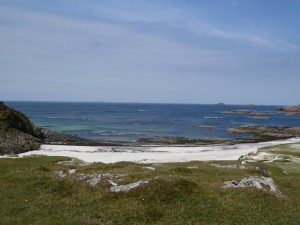
Iona shoreline
This Island set apart
This island set apart, this motherland of many dreams, still yields its secret, but it is only as men seek that they truly find. To reach the heart of Iona is to find something eternal…. G. E. Troup